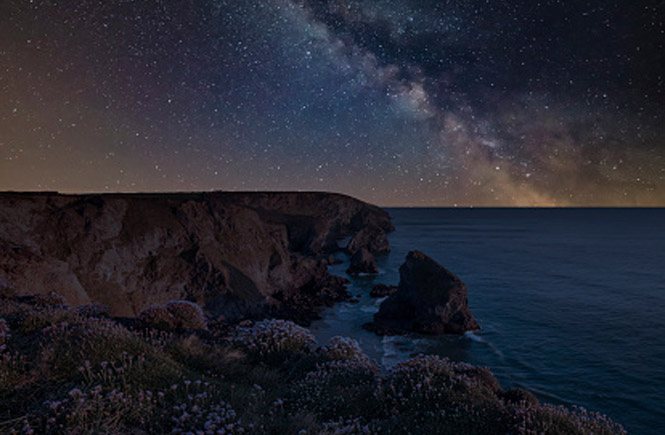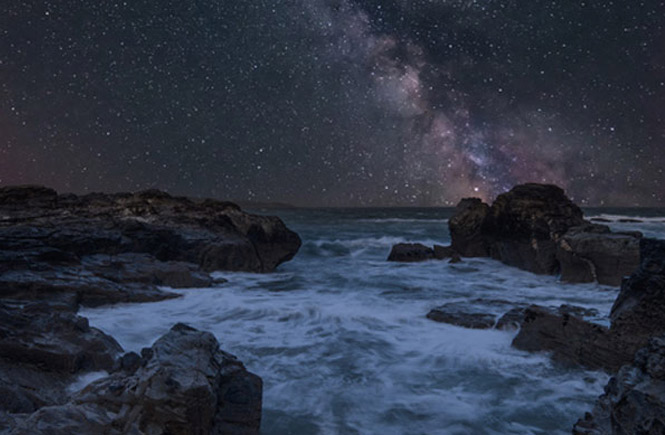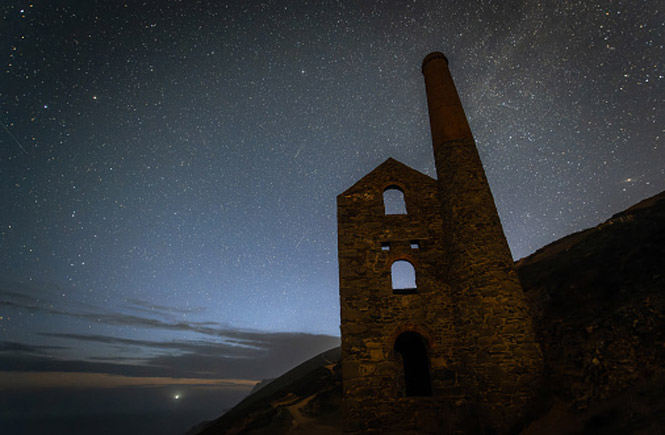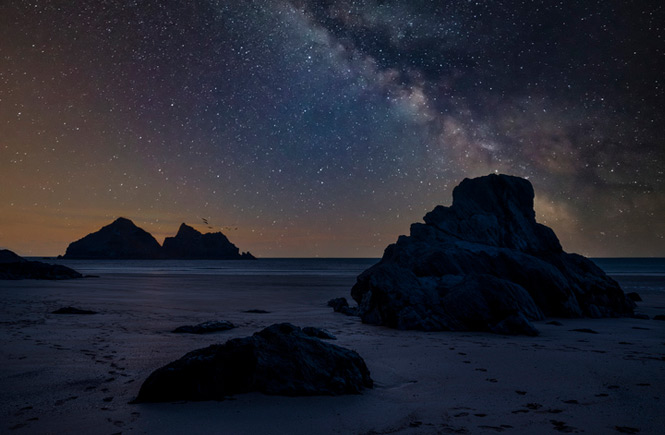Astro-tourism is growing in popularity in Cornwall owing to its lofty position amongst International Dark Sky Park and Dark Sky Discovery Site lists. These designated sites also happen to sit in National Landscapes (formerly Areas of Outstanding Natural Beauty) meaning that day or night – a trip to Cornwall’s best stargazing spots will reward visitors with a heavenly feast for all the senses.
With gorgeous locales including lakes, headlands, engine houses, woodlands and beaches providing the best spots for stargazing in Cornwall, you can explore a range of natural landscapes while embarking upon your astrological tour.
What’s more, there’s a growing community of groups, individuals and organisations coming together to discover Cornwall’s night sky in all its awe-inspiring glory, from societies to monthly meetings and special events; so whether you’re an utter novice or keen astronomer – you’re bound to find some company and a star-studded dark sky to suit.
Glimpse out of the window or from the garden of your holiday cottage to see if you can spy a constellation with the kids, take a romantic couple’s night-time stroll along a footpath while marvelling at the Milky Way, or sign up to a stargazing group gathering for insider knowledge and access to the very best that Cornwall’s night sky has to offer. Here’s our guide to the best spots for stargazing in Cornwall...
Designated International Dark Sky Park

Bodmin Moor
Situated in a National Landscape (formerly Area of Outstanding Natural Beauty), Bodmin Moor received its Designated International Dark Sky Park status in 2017. Awarded as a result of its sky quality, along with its conservation commitments to avoid light pollution, the entire area’s low level of artificial light makes it a top choice for year-round stargazing. Minions, Cardinham Woods, Crowdy Reservoir and Colliford Lake are some of the most popular stargazing locations in the national park, along with Siblyback Lake in nearby Liskeard - but practically anywhere within the 208 square kilometre area will reward visitors with a vast expanse of dark skies.
West Penwith
Having achieved recognition by the International Dark-Sky Association in 2021, West Penwith’s Dark Sky Park also sits in a National Landscape (formerly Area of Outstanding Natural Beauty). Sweeping from St Ives to St Just, Sennen and Land’s End over to Mousehole (and inland to Newmill, Sancreed and Trethewey), the sprawling site marks one of the best places in the world to study the night sky. As such, there’s a variety of places perfectly primed for stargazing, from the landmark of Land’s End itself to the ancient Merry Maidens standing stones, St Ives Bay-facing Godrevy Beach, rocky Porth Nanven, the sweeping panoramas of Godolphin Hill, and Cornish Mining World Heritage Site (WHS) of Botallack.
Dark Sky Discovery Sites
Carnewas and Bedruthan Steps
Visit this area before dark for one of north Cornwall’s most jaw-dropping coastal views, where the jagged rock formations strewn across the sands are a vision of dramatic beauty. Take a stroll along this section of the South West Coast Path, which lies between Newquay and Padstow, and stash a picnic for sunset before loitering or returning to stargaze at this lauded Dark Sky Discovery Site. The National Trust organises special stargazing events here, and there is a car park with a grassy picnic area that provides the perfect accessible spot to sit and gaze into the beyond.
St Agnes Head
The second of Cornwall’s Dark Sky Discovery Sites (and hence, one of the best stargazing locations in the country), St Agnes Head is another north coast venue situated between Porthtowan and Perranporth. Stroll along the coast path to the magnificent Wheal Coates tin mine and find a piece of heathland from which to become bedazzled by the coupling of dark sky and night sea. Alternatively, if the tide permits – decamp to the beach for a spot of stargazing, or escape to anywhere on this stretch of heritage coastline such as Perranporth or Holywell Bay for an abundance of open skies and celestial bodies.
Observatories
Caradon Observatory
Situated on the edge of Bodmin Moor’s International Dark Sky territory in the landlocked heart of the county, Caradon Observatory is home to four domes packed with instruments that are primarily used for research and education, though there are apparently plans to provide future access to visitors. A roster of events are organised here and throughout the area at locations such as Siblyback Lake and Jamaica Inn, and include special talks, presentations, interactive activities, and galaxy hunting through large telescopes.
Roseland Observatory
Though visiting the observatory here is by prior arrangement only, the Truro High School for Girls is home to the Roseland Observatory, which also boasts a Willow Field for telescopes to be set up in. Regular events include Open Days, Telescope Clinics and Away Days, all arranged by the Director, Brain Sheen. Monthly night sky sessions throughout the year are scheduled to coincide with meteor showers, planet spotting, moon phases, eclipses and a host of other exhilarating sights in space, and well worth attending if your holiday falls during these cosmic events.
Best Stargazing Sites

Chapel Carn Brea, Penzance
The most southwesterly of West Penwith’s hills lies near Land’s End airport and presents the best dark sky for stargazing, so hike up the Hercynian granite outcrop for unrivalled views on a clear night. The National Trust car park is located nearby, from where you can take a circular one-mile route to the summit and back.
Carn Galver Engine House, Zennor
Located on the coast road between St Ives and St Just, you might want to make a visit to this site with a ramble such as Bosigran circular walk, or simply as part of your star search. The pair of historic engine houses provides a stunning silhouette against a starlit sky and overlooks the vast Atlantic ocean off the north coast. A free car park can be found near between the road and buildings, which is also close to the coast path.
Goonhilly Earth Station Nature Reserve, The Lizard
The Lizard peninsula is replete with dark skies due to its low light pollution and open landscapes. Goonhilly’s Nature Reserve features a rural car park to gaze from; or you can venture to the picture postcard coastal destination of nearby Kynance Cove, where a National Trust car park sits atop the cove on the headland, offering up clear southerly views alongside Dark Site quality skies.
Lantic Bay, Fowey
Situated just outside Fowey on the subtropical south coast, Lantic Bay presents a picturesque beach locale by day and stargazing destination by night. You’ll find a little sky glow, but with low light pollution and rolling farmlands falling into expansive oceans, plenty of darkened landscapes for star spotting.
Rinsey Head
Between Penzance and Helston on a soul-stirring section of the South West Coast Path, Rinsey Head boasts light pollution akin to a Dark Site location along with spectacular seascapes across the channel. There’s a car park on the headland, or take a stroll and perch by Wheal Prosper for photos with a distinctively Cornish difference.
Trelissick, Feock
For Fal Estuary views and rural-level local light pollution that’s ideal for stargazing, Trelissick’s south coast position is a superb spot. Situated between Truro and Falmouth – but far enough away from their light pollution – the National Trust car park is a popular venue for stargazers that flock here for the impressively dark skies.
Resources and tips:

What to take: Torch, binoculars, camera, warm clothing/drinks, phone (as well as for emergencies, apps such as Star Walk and Google Sky are useful)
When to go: The best observing seasons are autumn, winter and spring, but you can stargaze at any time. Meanwhile, the best time to spot the Milky Way is between February and September; while if it’s planet sighting you prefer - aim for midnight when they’re at their highest point in the sky. Keep an eye on the moon phase (just before, during and after the new moon is the best time when the sky is at its darkest) and/or during the nightly period of ‘nautical twilight’ – when the sun is 12 degrees or more below the horizon and the skies are considered dark enough for stargazing: use a Dark Sky Calendar to plan your outing.
Visit: gostargazing.co.uk, cornwall-aonb.gov.uk/dark-skies and Kernow Astronomers for more information.
Feeling inspired to plan for your stargazing holiday to Cornwall? We have a huge variety of cottages throughout the county – including in and near Cornwall’s Designated International Dark Sky Parks and Dark Sky Discovery Sites.
Tags: Fowey | Land's End | Penzance | St Agnes | Zennor | Photography |


